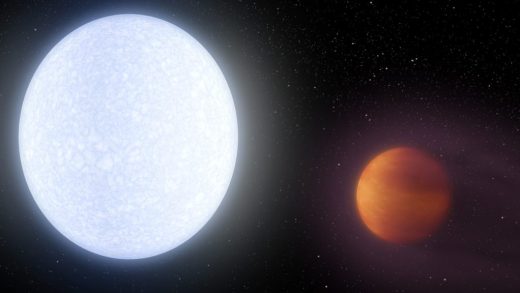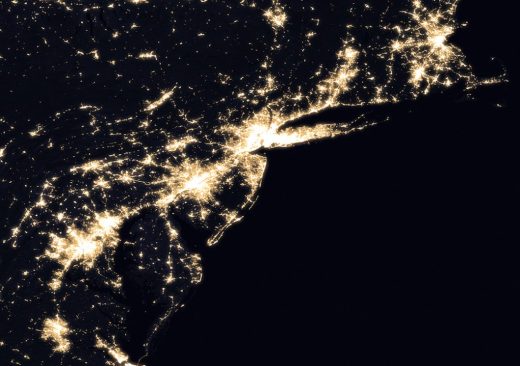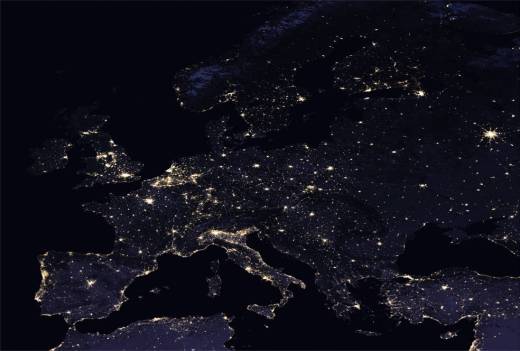Here is a NASA article about how artists create imagery of planets around other stars realistically despite the fact no one has ever seen such an exoplanet up close:
The moon hanging in the night sky sent Robert Hurt’s mind into deep space — to a region some 40 light years away, in fact, where seven Earth-sized planets crowded close to a dim, red sun.

Hurt, a visualization scientist at Caltech’s IPAC center, was walking outside his home in Mar Vista, California, shortly after he learned of the discovery of these rocky worlds around a star called TRAPPIST-1 and got the assignment to visualize them. The planets had been revealed by NASA’s Spitzer Space Telescope and ground-based observatories.
“I just stopped dead in my tracks, and I just stared at it,” Hurt said in an interview. “I was imagining that could be, not our moon, but the next planet over – what it would be like to be in a system where you could look up and see continental features on the next planet.”
So began a kind of inspirational avalanche. Hurt and his colleague, multimedia producer Tim Pyle, developed a series of arresting, photorealistic images of what the new system’s tightly packed planets might look like — so tightly packed that they would loom large in each other’s skies. Their visions of the TRAPPIST-1 system would appear in leading news outlets around the world.
Artists like Hurt and Pyle, who render vibrant visualizations based on data from Spitzer and other missions, are hybrids of sorts, blending expertise in both science and art. From squiggles on charts and columns of numbers, they conjure red, blue and green worlds, with half-frozen oceans or bubbling lava. Or they transport us to the surface of a world with a red-orange sun fixed in place, and a sky full of planetary companions.
“For the public, the value of this is not just giving them a picture of something somebody made up,” said Douglas Hudgins, a program scientist for the Exoplanet Exploration Program at NASA Headquarters in Washington. “These are real, educated guesses of how something might look to human beings. An image is worth a thousand words.”

Hurt says he and Pyle are building on the work of artistic pioneers.
“There’s actually a long history and tradition for space art and science-based illustration,” he said. “If you trace its roots back to the artist Chesley Bonestell (famous in the 1950s and ’60s), he really was the artist who got this idea: Let’s go and imagine what the planets in our solar system might actually look like if you were, say, on Jupiter’s moon, Io. How big would Jupiter appear in the sky, and what angle would we be viewing it from?”
To begin work on their visualizations, Hurt divided up the seven TRAPPIST-1 planets with Pyle, who shares an office with him at Caltech’s IPAC center in Pasadena, California.

Hurt holds a Ph.D. in astrophysics, and has worked at the center since he was a post-doctoral researcher in 1996 – when astronomical art was just his hobby.
“They created a job for me,” he said.
Pyle, whose background is in Hollywood special effects, joined Hurt in 2004.

Hurt turns to Pyle for artistic inspiration, while Pyle relies on Hurt to check his science.
“Robert and I have our desks right next to each other, so we’re constantly giving each other feedback,” Pyle said. “We’re each upping each other’s game, I think.”
The TRAPPIST-1 worlds offered both of them a unique challenge. The two already had a reputation for illustrating many exoplanets – planets around stars beyond our own — but never seven Earth-sized worlds in a single system. The planets cluster so close to their star that a “year” on each of them — the time they take to complete a single orbit — can be numbered in Earth days.
And like the overwhelming majority of the thousands of exoplants found in our galaxy so far, they were detected using indirect means. No telescope exists today that is powerful enough to photograph them.

Real science informed their artistic vision. Using data from the telescopes that reveal each planet’s diameter as well as its “weight,” or mass, and known stellar physics to determine the amount of light each planet would receive, the artists went to work.
Both consulted closely with the planets’ discovery team as they planned for a NASA announcement to coincide with a report in the journal Nature.
“When we’re doing these artist’s concepts, we’re never saying, ‘This is what these planets actually look like,’” Pyle said. “We’re doing plausible illustrations of what they could look like, based on what we know so far. Having this wide range of seven planets actually let us illustrate almost the whole breadth of what would be plausible. This was going to be this incredible interstellar laboratory for what could happen on an Earth-sized planet.”
For TRAPPIST-1b, Pyle took Jupiter’s volcanic moon, Io, as an inspiration, based on suggestions from the science team. For the outermost world, TRAPPIST-1h, he chose two other Jovian moons, the ice-encased Ganymede and Europa.

After talking to the scientists, Hurt portrayed TRAPPIST-1c as dry and rocky. But because all seven planets are probably tidally locked, forever presenting one face to their star and the other to the cosmos, he placed an ice cap on the dark side.
TRAPPIST-1d was one of three that fall inside the “habitable zone” of the star, or the right distance away from it to allow possible liquid water on the surface.
“The researchers told us they would like to see it portrayed as something they called an ‘eyeball world,’” Hurt said. “You have a dry, hot side that’s facing the star and an ice cap on the back side. But somewhere in between, you have (a zone) where the ice could melt and be sustained as liquid water.”
At this point, Hurt said, art intervened. The scientists rejected his first version of the planet, which showed liquid water intruding far into the “dayside” of TRAPPIST-1d. They argued that the water would most likely be found well within the planet’s dark half.
“Then I kind of pushed back, and said, ‘If it’s on the dark side, no one can look at it and understand we’re saying there’s water there,’”
Hurt said. They struck a compromise: more water toward the dayside than the science team might expect, but a better visual representation of the science.

The same push and pull between science and art extends to other forms of astronomical visualization, whether it’s a Valentine’s Day cartoon of a star pulsing like a heart in time with its planet, or materials for the blockbuster announcement of the first detection of gravitational waves by the Laser Interferometer Gravitational-Wave Observatory in February 2016. They’ve also illustrated asteroids, neutron stars, pulsars and brown dwarfs.
Visualizations based on data can also inform science, leading to genuine scientific insights. The scientists’ conclusions about TRAPPIST-1 at first seemed to suggest the planets would be bathed in red light, potentially obscuring features like blue-hued bodies of water.
“It makes it hard to really differentiate what is going on,” Hurt said.
Hurt decided to investigate. A colleague provided him with a spectrum of a red dwarf star similar to TRAPPIST-1. He overlaid that with the “responsivity curves” of the human eye, and found that most of the scientists’ “red” came from infrared light, invisible to human eyes. Subtract that, and what is left is a more reddish-orange hue that we might see standing on the surface of a TRAPPIST-1 world — “kind of the same color you would expect to get from a low-wattage light bulb,” Hurt said. “And the scientists looked at that and said, ‘Oh, ok, great, it’s orange.’ When the math tells you the answer, there really isn’t a lot to argue about.”
For Hurt, the real goal of scientific illustration is to excite the public, engage them in the science, and provide a snapshot of scientific knowledge.
“If you look at the whole history of space art, reaching back many, many decades, you will find you have a visual record,” he said. “The art is a historical record of our changing understanding of the universe. It becomes a part of the story, and a part of the research, I think.”
For more information on exoplanets, visit: https://exoplanets.nasa.gov
Written by Pat Brennan







